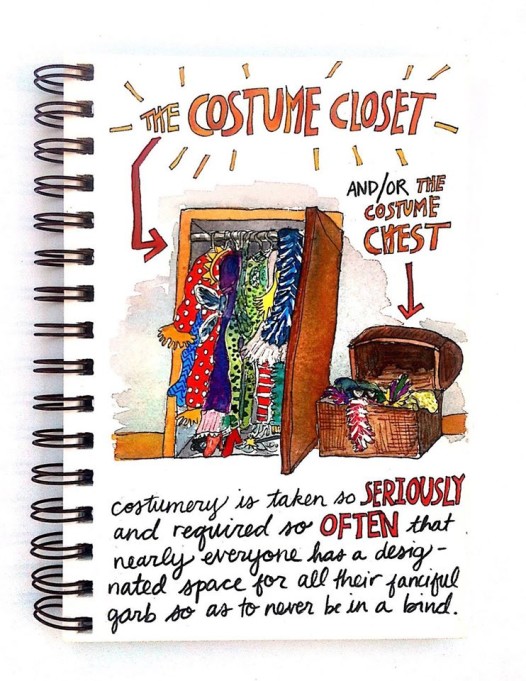Editor’s Note: To get us in the mood for Mardi Gras (who are we kidding, we’re all in the mood for Mardi Gras already), we are diving into the sugary, sensual, and silly side that makes this the most wonderful time of the year! Move over, Christmas! This entire week we will be celebrating the food, the culture, the music, and the traditions of Mardi Gras for our “Carnival Craving” series.
Now that it’s Lundi Gras and your costuming is coming down to the wire (hot glue emergencies), here’s what Kelley Crawford found that your costume says about you.

(Illustration by: Emma Fick) Illustrator and writer Emma Fick is the published author of Snippets of Serbia and Snippets of New Orleans. To see more of Emma’s work and learn more about her, visit her website or find her on Instagram and Facebook.
When I was growing up in small-town Illinois where the smell of pumpkins was constant and the sound of change was rare, my mom and dad used to tell me stories about living in New Orleans. Now that Lundi Gras is upon us and our minds are even more occupied with thoughts of glue guns, sequins, fringe, and beading, I remember the story my parents told me about their first Carnival after they moved to New Orleans (at the ripe ages of 21).
As a young girl I’d envision their details of New Orleanians walking through the streets with feathers sprouting from their necks, their arms, and even down their calves. There were descriptions of how beaded costumes caught the light and literally shaped worlds that lived on someone’s chest or shoes. People wobbled in these stories after a night of parades and drinking, and my parents would follow it up with, “And that was just Monday. Tuesday is when it really came alive.”
From those stories (and even up until today) New Orleans reflected this real-life Atlantis, and now having elevated from a box to a full closet full of costumes, I’ve come to realize the transcendent role costuming plays in this mythical existence that New Orleans exudes and embraces.
It reminds me of what Wendy Doniger says about costumes in her essay “Many Mask, Many Selves.” That’s right, academics and costuming go way back (or in Doniger’s case, back to 2006 with the publication of the piece in Daedalus). Doniger says, “In both real life and mythology, people set out to become other people but, through a kind of triple cross or double-back, end up as themselves, masquerading as other people who turn out to be masquerading as them.” A triple cross? A double cross of the self? Doniger, I like it!
This could possibly explain why that extremely timid co-worker who avoids eye contact in the office shows up in a parade wearing nothing but a cape and pasties. Or why that stranger at the Chewbacchus parade – dressed as an amoeba made fully of tin foil – recounts his tragic head injuries from his football glory days and confesses that when he can’t sleep at night he watches marathon runs of Full House and Real Housewives. Could this have something to do with the armor they’re wearing and the invincibility they’re feeling because of their costume? Well, I don’t see why not.
Costuming is a way of letting go and plugging into the community in a way that isn’t really acceptable on a day-to-day basis (even in New Orleans where norms are not really typical norms). It’s a way of dressing yourself up, masking your face from the world in order to tap into what might be hiding under all those layers of material and skin. And, it’s an invitation to connect. If someone is wearing a furry suit that looks like the blanket from your childhood, there’s little to stop you from asking, “Can I touch that?” and them most likely exuberantly responding with an “Of course” and an extended appendage all for your liking.
We all know that love and Carnival go hand-in-hand, and I can’t help but think that costuming has a huge part in that. In fact, I’m going to let Doniger say how it really is. As she states, “I think, we often fall in love with the people who love, among our many masks, the mask that we too love best, feel happiest in – the self that we prefer to pretend to be.”
So get suited up and see what you’re made of. You might surprise yourself, and that’s not something we get to do all that often in life. Well, except in New Orleans!
 NOLAbeings Multimedia artist Claire Bangser created NOLAbeings as a portrait-based story project that marries...
NOLAbeings Multimedia artist Claire Bangser created NOLAbeings as a portrait-based story project that marries...  Voodoo in New Orleans: Reviving history: New Orleans fortune telling This article takes a deep dive into the history of Voodoo in New Orleans, its hybridization with Catholicism, and its present-day place in the city's culture. The author visits fortune-tellers in the French Quarter, using their guidance as a tool for introspection rather than a deterministic predictor of the future. Through her experiences in New Orleans, the author feels a mystical connection to both the past and the future.
Voodoo in New Orleans: Reviving history: New Orleans fortune telling This article takes a deep dive into the history of Voodoo in New Orleans, its hybridization with Catholicism, and its present-day place in the city's culture. The author visits fortune-tellers in the French Quarter, using their guidance as a tool for introspection rather than a deterministic predictor of the future. Through her experiences in New Orleans, the author feels a mystical connection to both the past and the future. 